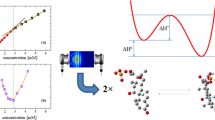Abstract
The effects of a polymer, the Li-salt copolymer of methyl-methacrylic acid, and its methyl ester on the motion of drug molecules in hydrocolloids were studied. The investigation was carried out by means of electron paramagnetic resonance (EPR) using the model nitroxide tempol, and the spin-labeled drugs lidocaine (si-lid) and dexamethasone (sl-dex). Synthesis of sl-dex was performed. Spin-labeled molecules dissolved in hydrocolloids undergo a fast reorientation motion. The decreasing order of rotational correlation times (τ) —sl-dex > si-lid > tempol—suggests that the size and the shape of the molecules strongly affect their motion. The inhibition of motion of larger molecules depends also on their flexibility. The τ values indicate proportionality of the microviscosity of hydrocolloids to the polymer concentration. Rotational motion is dependent on the local environment conditioned by the free spaces between polymer molecules.
Similar content being viewed by others
REFERENCES
A. H. Muhr and J. M. V. Blanshard. Diffusion in gels. Polymer 23:1012–1026 (1982).
S. H. Gehrke and P. I. Lee. Hydrogels for drug delivery systems. In P. Tyle (ed.), Specialized Drug Delivery Systems, Marcel Dekker, New York, 1990, pp. 333–392.
P. F. Knowles, D. Marsh, and H. W. E. Rattle. Magnetic Resonance of Biomolecules, Wiley, New York, 1976.
J. Kristl, S. Pečar, J. Šmid-Korbar, F. Demšar, and M. Schara. Drug diffusion: A field gradient electron paramagnetic resonance study. Drug Dev. Ind. Pharm. 15:1423–1440 (1989).
M. Le Meste and A. Voilley. Influence of hydration on rotational diffusivity of solutes in model systems. J. Phys. Chem. 92:1612–1616 (1988).
T. C. Sandreczki and I. M. Brown. Motional behavior and correlation times of nitroxide spin probes in polymers above and below the glass transition. Macromolecules 21:504–510 (1988).
J. Šmid-Korbar, J. Kristl, and H. Rupprecht. Pharmaceutically relevant properties of polymethylmethacrylate-lithium-hydrocolloids. Pharmazie 44:477–480 (1989).
H. O. Hankovszky, K. Hidek, and J. Tigyi. Nitroxides, II, 1-oxyl-2,2,5,5-tetramethyl-pyrroline-3-carboxylic acid derivatives. Acta Chim. Acad. Sci. Hungar. 98:339–348 (1978).
D. March. Electron spin resonance: Spin labels. In E. Grell (ed.), Membrane Spectroscopy, Springer Verlag, Berlin, 1981, pp. 51–142.
Author information
Authors and Affiliations
Rights and permissions
About this article
Cite this article
Kristl, J., Pečar, S., Šmid-Korbar, J. et al. Molecular Motion of Drugs in Hydrocolloids Measured by Electron Paramagnetic Resonance. Pharm Res 8, 505–507 (1991). https://doi.org/10.1023/A:1015859429980
Issue Date:
DOI: https://doi.org/10.1023/A:1015859429980



